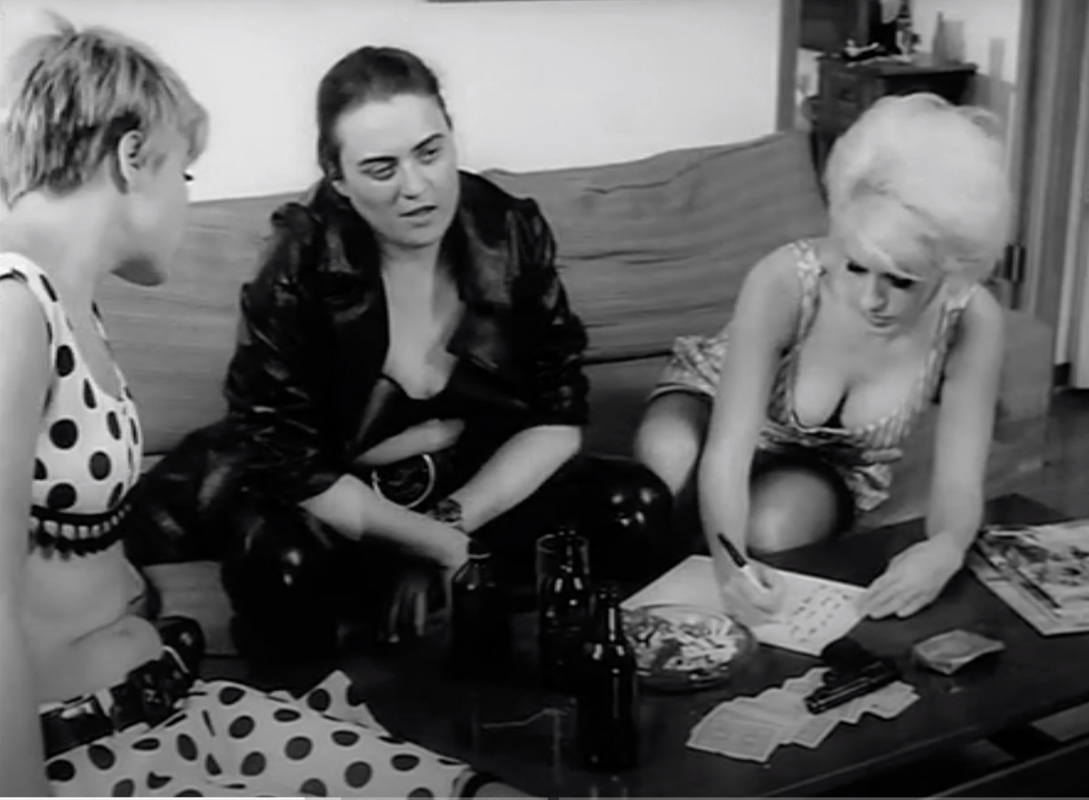
Vibrations was written and directed by Joseph Sarno. During his 40 year career, Sarno directed 125 films, 75 of which he also wrote. In the 1960s he was a pioneer of the sexploitation genre, but his films often had an eye toward serious cinema. He was interested in psychological tension and the ways in which people manipulate each other. His early films have the obligatory titillating titles, but often there was a hint of something more, like Sin in the Suburbs, The Indelicate Balance, and Nude in Charcoal.
Sarno’s early films feel a bit like Trojan horses trying to sneak art into dirty movie theaters. The sexploitation genre relied heavily on lurid titles and provocative posters to get people into the theaters but most of the time what the audience got was little more than some nudity and a few tepid softcore scenes of unenthusiastic actors grinding. Sarno provided the requisite sexual content but with a more potent eroticism and included some serious-minded drama as well.
Later in the 1980s Sarno would leave any pretension of artistry behind and dedicate himself to straightforward pornography. The titles changed from Red Roses of Passion and
Step Out of Your Mind to humorous titles like Screw the Right Thing, Hung Jury, The Erotic Adventures of Bedman and Throbbin, 21 Hump Street, and Ball in the Family.
Vibrations is one of Sarno’s early films from 1968. It’s one of three films made in quick succession in an apartment in New York City. Vibrations takes itself seriously and is heavily influenced by Ingmar Bergman’s films. One could even call it an homage to Persona. Like Persona, Vibrations is a stark movie. It is filmed in rooms with blank white walls or peering out windows at the mostly empty streets below. The characters have no distractions or diversions, only each other to contend with. There is nowhere to hide. The dialogue is direct and simple and the film is dominated by just two characters, Barbara and Julia. They are sisters. Barbara is the responsible but repressed one and Julia is the free-spirited sexual one.
With such different personalities, their relationship is strained and turbulent but is made even more tense by the fact that they used to be sexual partners. Their past incest seems to be the cause of both Barbara’s frigidity and Julie’s promiscuity. The sexual emphasis doesn’t sound much like Bergman’s Persona but visually Sarno practically reproduces Bergman’s compositions.

Like in a Bergman film, characters rarely look at each other and often deliver dialogue to the back of each other’s heads. Bergman often used this composition to emphasize tension as if the characters could not bear to fully confront each other. In both Persona and Vibrations, almost everything is eliminated from the frame save the two principles locked in complex conflict.

In Persona Bergman provides us with two women Elisabet and Alma. The two of them may be representations of the same individual woman, or they may be two women tangled in a codependent spiral of disassociation and blurred boundaries. In Vibrations the same dynamic surfaces between Barbara and Julia. Sarno does not manage to render his characters or their relationship with the depth and skill of Bergman, but it is surprising that Sarno even attempts to do these things in a movie that probably cost 2000 dollars and was destined for a grindhouse theater somewhere in Time Square.
Of course along with his efforts to be an auteur Sarno knew the rules of the game and so inserted a generous amount of gratuitous nudity and sex. Certainly, Sarno knew he was pandering but it also seems likely that he believed the sex was an important part of the film. The inclusion of sex does intensify the film and heighten the tension between the two women.
Barbara and Julia live next to a group of libertines who wait like a spider in a web for anyone curious enough to poke their head in the open apartment door. The sexually ravenous coven draws people in and then envelope them in orgiastic indulgences. Barbara and Julia can hear their neighbors’ escapades through the wall and it drives both of them to distraction. Barbara is aroused and ends up masturbating several times while eavesdropping. Julia is disturbed and conflicted by the sensuality seeping into her apartment.
The two sisters may be two sides of the same person, but the two apartments could also represent two sides or facets of the same mind. In Freudian terms, which were all the rage in the 1060s, the sister’s side could be seen as the ego, or conscious mind and the neighbor’s side as the id or sub-conscious side. This is reminiscent of Joe Massot’s movie Wonderwall which came out in the same year as Vibrations. In Wonderwall, we see a nerdy scientist type seduced by a hip young model who he watches through a peephole in his apartment wall. Both movies could be seen as reflecting the mental split of the human psyche or as a larger societal split between the sexually indulgent and sexually repressed. The late 60s was marked by hundreds of films concerned with the consequences of allowing female sexuality out into the open.

Vibrations would be a much better movie if it were edited down to 40 minutes. It is ridiculously repetitive. There are basically three kinds of scenes, dialogue scenes, sex scenes, and scenes of Julia walking aimlessly around New York City. These three elements are on a relentless loop, simply repeating without any reason. There is a kind of bold strength the movie garners from having so few elements and such stark imagery, but there is a point of diminishing return.

Vibrations feels like a film made by a young auteur straining at the bit, looking for his first big break. It wasn’t until the late 1960s that American colleges and universities offered a degree in film studies. Filmmakers mostly learned on the job. Directors like Francis Ford Coppola and Martin Scorsese were paying their dues by making dirty grindhouse fodder, and Sarno was struggling along with them. Grindhouse theaters were like the folk music bars in the village where Woody Guthrie and Bob Dylan began or the warehouses of Soho where Andy Warhol and Lou Reed were trying to find a way into the larger cultural dialogue.
For every Dylan, Warhol, or Scorsese, there were 1000s who didn’t make it. Joseph Sarno is an interesting case of an artist who was there in the thick of it but never managed the leap into the big time. Sarno is not an overlooked genius or unsung hero, but his films did emerge from the same rich and ambitious pool the New York City underground.

If you enjoyed this article you might also enjoy this -
www.filmofileshideout.com/archives/the-abnormal-woman



